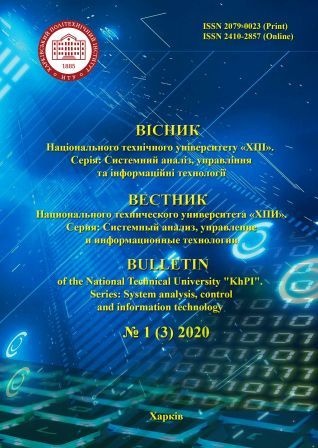OPTIMAL CONTROL OF A STEP-BY-STEP TRANSMISSION OF VEHICLES
DOI:
https://doi.org/10.20998/2079-0023.2020.01.08Keywords:
automatic transmission, optimal control, vehicle, universal engine performance, gear shift line, fuel efficiencyAbstract
The actual problem of optimal selection of means of transport (MT) gear ratios, equipped with internal combustion engines (ICE) with a step-by-step gearbox according to the criterion of minimum fuel consumption is considered in the article. An analysis of the scientific and technical literature has showed the absence of simple and sufficiently justified algorithms for controlling the vehicle’s power plant, which is a system that consists of an ICE and an adjustable transmission. The aim of this work is the theoretical justification of the law of gear ratios shifting of a step-by-step transmission, ensuring maximum fuel efficiency for any power and speed mode of MT. The proposed method is based on set of linear transformations that connect the engine moment and engine speed with a traction force and a speed of MT. The set of gear ratios correspond to the set of one-extremal functions of specific fuel consumptions. The set of points of equal levels lines corresponding to two neighboring values of the gear ratios of the transmission forms a gear shift line. An appropriate algorithm for switching gear ratios is proposed, which ensures the most efficient operation of a power plant of MT in conditions of variable power and speed modes.References
Krutov V. I. Avtomaticheskoe regulirovanie dvigatelej vnutrennego sgoranija [Automatic control of internal combustion engines]. Moscow, Mashinostroenie Publ., 1968. 535 p.
Aizerman M. A. Teorija avtomaticheskogo regulirovanija dvigatelej [Theory of automatic regulation of engines]. Moscow, Gosteorizdat Publ., 1952. 510 p.
Antonov A. S. Silovye peredachi kolesnyh i gusenichnyh mashin. Teorija i raschet [Power transmission of wheeled and tracked vehicles. Theory and calculation]. Moscow, Mashinostroenie Publ., 1976. 477 p.
Filkin N. M., Shaikhov R. F., Buyanov I. P. Osnovy teorii issledovanija jekspluatacionnyh svojstv avtomobilja [Fundamentals of the theory of the study of operational properties of a car]. Perm, Perm State Agricultural Academy Publ., 2016. 241 p.
Kondrashkin A. S. Umnyashkin V. A., Filkin N. M. Optimizacija zakonov perekljuchenija peredach [Optimization of the laws of gear shifting]. Avtomobil'naja promyshlennost'. 1988, vol. 10, pp. 19–20.
Kondrashkin A. S., Filkin N. M. Рaschet optimal'nyh momentov perekljuchenija peredach pri razgone [Calculation of the optimal moments of gear shifting during acceleration]. EVM v issledovaniiakh raboty ATS. Mezhvuzovskii sbornik nauchnykh trudov [Computers in the study of the operation of automatic telephone exchanges. Interuniversity collection of scientific papers]. Moscow, MIP Publ., 1988, pp. 45–48.
Pavlenko A. V. Metod opredelenija rjada peredatochnyh chisel transmissii na rannih jetapah proektirovanija [Method for determining a number of transmission ratios at the early stages of design]. Sbornik nauchnyh trudov [Collection of scientific papers]. 2001, issue 7–8, pp. 100–102.
Pavlovsky V. E., Ogoltsov V. N., Ogoltsov N. S. Sistema upravlenija nizhnego urovnja dlja avtomobilja s mehanicheskoj transmissiej [Lower level control system for a car with a mechanical transmission]. KIAM Preprints M. V. Keldysh Publ., 2013, vol. 103, 28 p.
Sakhno V. P. Kornach A. A. Opredelenie peredatochnyh chisel transmissii pri uslovii minimal'nogo rashoda topliva v ustanovivshemsja dvizhenii avtomobilja [Determination of gear ratios of a transmission under the condition of minimum fuel consumption in steady-state vehicle movement]. Vestnik Nacional'nogo transportnogo universiteta. Serija “Tehnicheskie nauki” [Bulletin of the National Transport University. Series "Engineering"]. Kiev, NTU Publ., 2015, issue 1 (31), pp. 469-475.
Krasnevsky L. G. Avtomaticheskie transmissii kak sredstvo povyshenija jenergojeffektivnosti silovyh ustanovok mobil'nyh mashin [Automatic transmissions of kA means of increasing the energy efficiency of power plants of mobile machines]. Perspektivnye materialy i tehnologii: sbornik materialov mezhdunarodnogo simpoziuma [Advanced Materials and Technologies: a collection of the international symposium materials]. Vitebsk, UO "VGTU", 2015, pp. 125–129.
Kuznetsov A. G. Analiz vozmozhnosti raboty dvigatelja s minimal'nym rashodom topliva [Analysis of engine operation with minimum fuel consumption]. Izvestija vysshih uchebnyh zavedenij. Mashinostroenie [News of higher educational institutions. Mechanical engineering]. 2015, no. 7, pp. 52–57.
Leonov I. V. Algoritm upravlenija jekonom ichnost'ju silovogo agregata s dizel'nym dvigatelem [The algorithm for controlling the efficiency of a power unit with a diesel engine]. Vestnik MGTU im. Baumana. Ser. Mashinostroenie [Bulletin of MSTU. Bauman. Ser. Mechanical engineering]. Moskow, 2018, no. 1, pp. 83–91.
Stechkin B. S. Teorija teplovyh dvigatelej. Izbrannye trudy [Theory of heat engines. Selected Works]. Moscow, Nauka Publ., 1977. 410 p.
Downloads
How to Cite
Issue
Section
License
Copyright (c) 2020 Bulletin of National Technical University "KhPI". Series: System Analysis, Control and Information TechnologiesAuthors who publish with this journal agree to the following terms:
- Authors retain copyright and grant the journal right of first publication with the work simultaneously licensed under a Creative Commons Attribution License that allows others to share the work with an acknowledgement of the work's authorship and initial publication in this journal.
- Authors are able to enter into separate, additional contractual arrangements for the non-exclusive distribution of the journal's published version of the work (e.g., post it to an institutional repository or publish it in a book), with an acknowledgement of its initial publication in this journal.
- Authors are permitted and encouraged to post their work online (e.g., in institutional repositories or on their website) prior to and during the submission process, as it can lead to productive exchanges, as well as earlier and greater citation of published work (See The Effect of Open Access).


